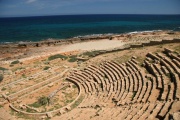Efessos
EPHESUS
Founded by Athens as a colony in the 10th century BCE, its historical origins are clouded in myth. For a brief period it was under the control of King Croesus of Lydia until Cyrus, the Persian King, defeated him in 547 BCE. The Persians controlled the city about 200 years until Alexander the Great captured it in 334 BCE. Then it became a Greek city for about 200 years until the Romans acquired it along with all of the province of Asia from Attalos III in 133 BCE, the king who gave the Stoa to Athens.
The Lydian influence in Ephesus produced a thoroughly mixed culture, part Greek, part Asiatic, more than anywhere else in the Greek East. Alexander's successor, Lysimachus (ca. 290 BCE), walled the city and parts of' the wall are yet visible. The city collaborated with Mithridates VI, king of Pontus, in his revolt against Rome in 88-85 BCE. A major incident was a one-day slaughter of (allegedly, but rather exaggerated) 80,000 Roman residents of Asia. Ephesus paid a high price, along with other Greek cities, as Rome retaliated to regain domination in the east. The city had also ceremoniously welcomed Antony and Cleopatra in the winter of 32-31 BCE, on their way to defeat at Actium in September of 31.
Still, beginning immediately with Augustus' reign (27 BCE), Ephesus entered an era of prominence and prosperity which lasted into the second century CE. Augustus made it the capital of the Roman province of Asia and it received the coveted title, "First and Greatest Metropolis of Asia." Imperial patronage included constructing aqueducts, paving streets, and enlarging agoras. During the Augustan era Ephesus was the largest commercial center in Asia, in fact, the third largest city in the Empire, after Rome and Alexandria, with a population of about 200,000. Its location was one of the many reasons for its commercial growth. The Royal Road, build by the Persians to run from Ephesus to Susa, the Persian capital, made it a gateway to and from the interior. The Romans used milestones in the city as the point of origin for measuring distances in Asia.
Ephesus prospered until the mid to late second century CE, but the increasing incompetence and cruelty of a series of Roman emperors in the late second and third centuries led to its decline. Ephesus also suffered from troubles on the eastern frontier of' the Empire in the 3d century, assassinations, pogroms against Christians, and the intervention of Goths from southern Russia. Gothic invaders heavily damaged the city and the Temple of Artemis, which was never restored to its former glory. Severe earthquakes in the late 4th and 7th centuries led to the partial desertion of the city.
Read more:
http://www.ephesus.us/ephesus/ephesus_history.htm
http://www.fotopedia.com/wiki/Ephesus#!/items/flickr-2409326851
http://www.livius.org/ei-er/ephesus/ephesus_photos1.html
http://www.ephesus-foundation.org/
http://www.ephesus.us/ephesus/templeofartemis.htm
http://en.wikipedia.org/wiki/Heraclitus
http://en.wikipedia.org/wiki/Epistle_to_the_Ephesians

















